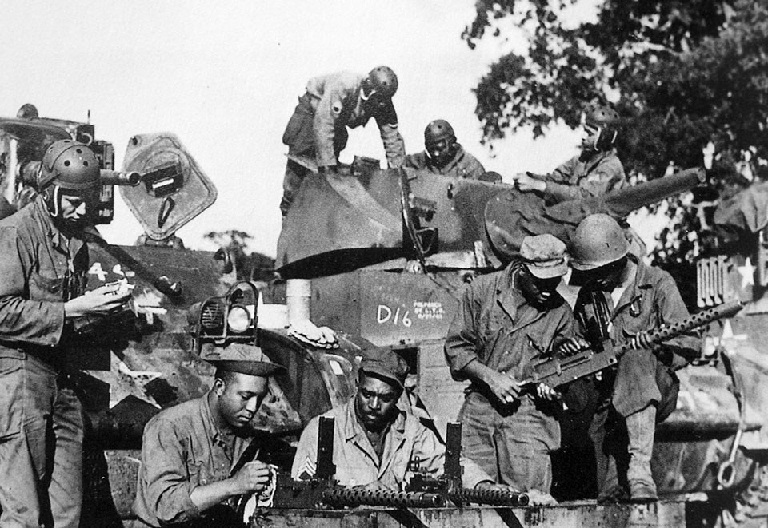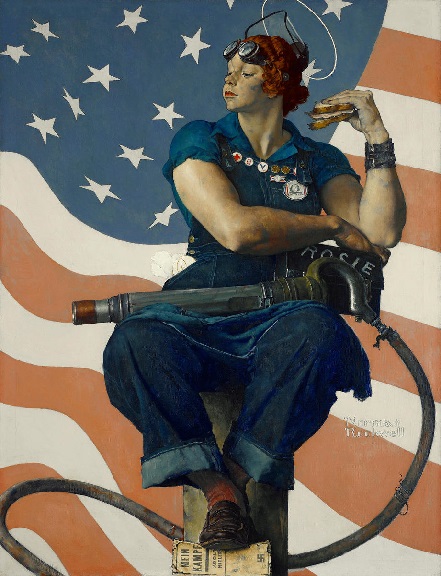The Experience of African Americans
Although the civil rights advances for African Americans during WWII were small, and mostly snatched back shortly after, Black veterans and workers came out of the war ready to challenge the racial discrimination they faced. WWII did not change their status, but it changed their minds.
|
|
In the Armed Forces
|
|
Before
The US airforce would not accept black pilots.
Black soldiers were not allowed to fight in the Marines – they served only
as cooks, transport or labourers.
In the Navy Black soldiers served only as mess men (cooks); in 1943 the Navy
had over 100,000 African Americans in service but not one black officer.
Black soldiers were not
allowed to train to be officers.
|
Advances
1.2 million African Americans
fought in the war.
An African American 332nd
fighter group known as the Tuskagee Airmen was set up; by the end of the war
there were 1,000 Black pilots.
The 761st Tank Battalion
– the ‘black panthers’ – fought in the Battle of the Bulge, 1944.
At Peleliu Island in the
Pacific 1944, the 17th SeeBee (Construction Brigade) company not only
rescued wounded soldiers under fire, but picked up their rifles and fought
back.
Black soldiers were
trained as officers.
African American women
were allowed to become nurses.
Some 400 Navajo Americans
served as code talkers.
Asian American recruits
were integrated into European American units; Chinese Americans were
promoted as officers.
The NAACP successfully
launched legal action to have the sentences reduced of the Black soldiers
convicted after the Port Chicago and Guam incidents.
Black servicemen and
women returned from the war having seen a world beyond their homes,
confident and ready to challenge the discrimination they faced.
In Feb-Mar 1945 the 6888th predominantly Black battalion of the US Women's Army Corps, led by Major Charity Adams, travelled to Birmingham, England, and cleared a backlog of 4 million undelivered items of mail.
|
Caveats
The military remained segregated, with the ‘Jim Crow Army’ relegated to support roles and facing unequal treatment and inferior facilities. The first Black recruits (1942) were not allowed on base unless accompanied by a white officer, and were assigned to inactive duty when trained.
In PoW camps, German prisoners ate in the white restaurants and used the white
latrines from which Black soldiers were barred.
Black officers were
allowed only to command Black soldiers; Black nurses could only treat Black
men.
The 1944
Port Chicago explosion &
‘mutiny’ highlighted the lack of training and unsafe conditions in which
African American soldiers had to work at the docks.
In 1944 racial tensions
in Guam ended with white Marines killing a number of Black Marines; when a
group of Black Marines chased the killers, they were arrested,
court-martialled, and sentenced to several years in prison.
|
|
In the Workplace
|
|
|
Maybe a million African
Americans moved from the rural South to urban areas in the North and West during
WWII.
By 1944 nearly 2 million
Black workers were employed in war-production.
When A. Philip
Randolph threatened a 100,000-strong protest march in 1941, Roosevelt issued
Executive Order 8802, which outlawed racial discrimination in the war
industry and set up the Fair Employment Practices Committee (FEPC) to
enforce it.
In 1944 the Supreme Court
ruled that US trade unions had a duty of ‘fair representation’ of both Black
and White workers.
Black workers ended the
war having held down ‘white’ jobs, more confident and ready to challenge the
discrimination they faced.
|
African Americans still
regularly received lower wages and faced discriminatory hiring and promotion.
Many were dismissed when
the war ended and the white soldiers returned.
African Americans continued to face discrimination in education and housing (e.g.
Levittown was for white veterans).
In 1943, discrimination
and racial tensions led to race riots in Detroit and attacks on
Mexican-Americans in the ‘Zoot Suit Riots’ in Los Angeles.
The FEPC had no authority
over private companies; it was ignored in the South, and in 1946 Congress
stopped its funding.
In a number of places during the war, notably in the automobile industry, white workers went on strike against the recruitment of black workers to ‘white jobs’
(such as that in 1943 at the Packard Motor Company in Detroit, where 25,000
white workers walked off the job when the firm announced it would train 12
African-American workers to positions previously reserved for whites).
The 1944 ‘fair representation’ ruling was not enforced until 1960.
|
|
Civil Rights
|
|
|
A ‘Double V’ Campaign called
for victory over fascism abroad and racism at home.
Membership of the NAACP
rose from 50,000 to 450,000.
The Congress of Racial Equality (CORE) was founded in 1942, and organised its first
sit-ins against segregated restaurants
in 1943.
In 1944, Irene Morgan, an
African American woman, was arrested for refusing to move from the ‘white’
seating section of a Greyhound interstate bus.
WWII galvanised the
African American civil rights movement.
|
22 African Americans –
including war veterans – were lynched 1941-46, and Black soldiers returned to
find white supremacy, discrimination and segregation unchanged, particularly in
the South.
An attempt in 1948 by President Truman to introduce civil rights was defeated in Congress.
He issued Executive Order 9981 desegregating the armed forced instead, but
it was resisted in the military, and not fully implemented until the Korean
War.
|
|
The Experience of Women
Although women contributed hugely to the war effort, they faced discrimination, and any advances they achieved during the war seem to have been lost when it ended.
American 'second wave' feminism did not appear until the 1960s.
|
In the Armed Forces
|
|
Before
|
Advances
350,000 women joined the armed forces
Women served in the
Women’s Army Corps (WAC), Women Airforce Service Pilots (WASP), the Women
Accepted for Volunteer Emergency Service (Navy WAVES) and the Marine Corps
Women’s Reserve.
They served as mechanics, drivers, gunnery instructors, air traffic controllers, weather forecasters and translators.
Navy WAVES built decryption machines called Bombes.
In 1945, Jane Kendeigh became the first U.S. Navy flight nurse to fly an evacuation mission to an active battlefield when she landed on Iwo Jima; Kendeigh and her fellow flight nurses would go on to evacuate some 2,400 Marines from Iwo Jima, tending their patients while transporting them to hospitals.
In Feb-Mar 1945 the 6888th predominantly Black battalion of the US Women's Army Corps, led by Major Charity Adams, travelled to Birmingham, England, and cleared a backlog of 4 million undelivered items of mail.
Sallie Braun ran the Army Port of San Francisco single-handed.
In 1948, Congress passed
the Women’s Armed Services Integration Act, which gave women the right to
serve in the military.
|
Caveats
Servicewomen faced gender
discrimination from the public and male colleagues.
Women of color confronted a double burden of racism and sexism.
The Navy did not accept Black women until 1944.
When the war finished,
most servicewomen were discharged and their units disbanded.
Women veterans were often
refused the benefits for veterans under GI Bill.
|
|
In the Workplace
|
Some middle class and married
women worked, but mostly in jobs such as nursing or teaching.
Women suffered wage
discrimination.
Unions opposed women in
employment.
|
1940-45 the number of women in
work rose from 12-19 million – women occupied a third of all jobs.
By the end of 1945, three million
women had
volunteered for the American Red Cross.
Women worked in
munitions, aircraft, railways and electronics – in 1939 36 women had worked
in shipbuilding; in 1942 there were 200,000.
Women worked in heavy-duty jobs such as welders and machinists.
Made famous in a 1942 song and by Norman Rockwell's poster, ‘Rosie the Riveter’ became a social icon of working women contributing to
the war effort.
A study by the Bureau of
Employment Security in 1942 found
that women paid more attention to detail, worked faster than their male
counterparts and required less supervision, and that accidents and damage to
tools was "considerably" less.
In 1943, Congress
allocated $20 million under the Lanham Act to fund hundreds of war nurseries
for an estimated 550,000 children.
Employment gave women the
experience of independence, responsibility and self-belief.
|
Women experienced sexual harassment and violence at work, in public, and in their homes.
Workplace newspapers spoke of women in sexual language as oddities in the
industrial sector.
Women occupied only 4% of
skilled jobs.
Women were still paid
less than male workers.
Unions sought assurances
that women’s wartime work would only be temporary.
Black, Latino, Native
American, and Asian American women faced particular racism and
discrimination in war work and society.
When the war ended, nearly all women were laid off
There was no long-term
gain in wage differentials; in 1944 a Bill prohibiting wage discrimination
for women failed in Congress.
The Lanham funding ended
with the war; it was to be America’s only-ever universal childcare
programme.
|
|
Civil Rights
|
|
|
During the war American
society accepted the idea of women in diverse roles.
Women experienced a shift
in public praise, as they were commended as being competent and intelligent.
The National Federation
of Business and Professional Women's Clubs (BPW) advocated for women's
rights in the workforce; in 1940 it devised a classification system for women with
specialized skills, which the War Manpower Commission used to allocate women
to appropriate jobs.
|
Many married women were happy
to return to their role as wives and mothers after the war; the number of women
in employment continued to decline.
‘Quickie’ wartime
marriages landed many women in unhappy relationships.
‘Second Wave’ feminism
did not appear until the 1960s.
|

